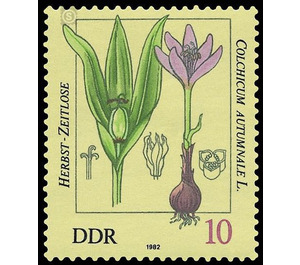poisonous plants - Germany / German Democratic Republic 1982 - 10 Pfennig
Theme: Flora
| Country | Germany / German Democratic Republic |
| Issue Date | 1982 |
| Face Value | 10.00 |
| Color | multi-colored |
| Perforation | K 14 |
| Printing Type | offset |
| Stamp Type | Postage stamp |
| Item Type | Stamp |
| Chronological Issue Number | 2433 |
| Chronological Chapter | GER-DDR |
| SID | 23126 |
| In 18 Wishlists | |
Poisonous Plants With the illustrations of poisonous plants, the Ministry of Posts and Telecommunications of the German Democratic Republic issues six multicolored special postage stamps. Special cancellation from April 6 to June 5, 1982 Poisonous plants "All things are poison, and nothing is without poison; but the dose makes that a thing is not a poison. "Theophrastus Bombastus of Hohenheim, gen. Paracelsus (1493-1541) wrote this statement in the light of the gradual transition from spice and medicinal to poisonous plants and the beneficial effects of such a plant the hand of the doctor whose uncontrolled use or misuse may be fatal.Various poisonous plants are extremely beautiful, show bright colors in flowers and fruits, or are so rare that we need to protect them.Their number is legion and in the plant world Our native flora has about 135 more or less poisonous plants, not counting the ornamental plants.Not all are deadly poisonous, but each affects the health considerably.Penny Value: Autumn-Timeless A lily plant (Liliaceae), its flesh-colored, pink or reddish-violet six-flowered flowers with long white or pale pink tube in the fall from the underground The spring leaves are followed by the dark green, juicy, tulip-like leaves as well as the capsule fruits ripening in June and then brown. All parts contain the cell and capillary toxin colchicine, an alkaloid that causes cholera-like symptoms, disorders of the nervous system, paralysis and cardiovascular damage.


